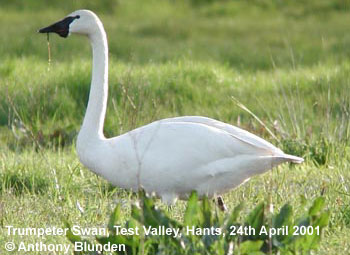
| EMAIL THIS PAGE TO PALS |
Trumpeter Swans - East Coast re-introductions and vagrancy potential

With the arrival of a Trumpeter Swan (Olor buccinator) amongst the regular wintering swans and geese in Hampshire, UK this winter, one surfbirder tipped us off to the US East Coast re-introduction programme. Whilst there's no suggestion of Trumpeter Swan vagrancy, we thought you'd like to know more ! Many thanks to Tony Blunden
According to the US Fish and Wildlife Service " The Trumpeter Swan's historic breeding range extended in a wide band from the Bering Sea east through almost all of Canada and south to Missouri, Illinois, and Indiana".
But hunting pressure and habitat loss early in the 20th century pushed 'trumpeters' almost to the brink of extinction. With the arrival of Europeans in the United States, 'trumpeter' feathers, quills, down and skins were quickly commodified "being used for everything from the manufacture of pens to powder puffs and bedding". In 1932, the US population outside of Alaska was estimated to number just 69 birds.
Today, the central Alaska population numbers some 13,000 birds and winters from southeastern Alaska along coastal British Columbia south to the mouth of the Columbia River on the southern border of Washington State. Although migratory this population is therefore a short-distance migrant only.
Other 'trumpeters' are found in mixed migratory/ non-migratory groups across the Great Basin region of Alberta, Washington, Oregon, Nevada, Montana, Wyoming, South Dakota, and Minnesota (known as the interior population) whilst a further 1,600 reside in Canada.
The Mississippi Flyway Swan Committee estimated that the Interior Population numbered 1,469 Trumpeter Swans in September 1997.
Over the last decade various re-introduction programmes have also been initiated along the East Coast, centred primarily around the Great Lakes Region.
One of the first of these was by Canadian biologist Harry Lumsden who began a reintroduction program to re-establish the Trumpeter Swan in its former habitat and range across Ontario in the early 80's. As many as 200 birds are now established in the southern part of the province. However the non-migratory behaviour (*1) of these birds has meant little or no contact with similarly introduced Michigan-Wisconsin-Minnesota populations. This leaves the Ontario population isolated and at risk. Researchers have studied methods of induced migration to help re-introduced birds find winter habitat.
(*1 Gavin Edmondstone from Ontario has commented - June 2001 - that since 1993 a significant proportion of this population do move off their breeding grounds in winter, migrating along the shore of Lake Ontario to suitable wintering habitat along western Lake Ontario. Although supplemented by hand-outs these birds are not dependent upon winter feed.)
More recently Ohio state has established a similar re-introduction programme, started in the late 90's, and aiming to establish 15 breeding pairs by 2006.
At present therefore, it would appear that re-introduced East coast populations are not strongly migratory, whilst the nucleus of the population of this once endangered species is a short distance migrant along the pacific coast only.
For on-line Trumpeter Swan identification notes, try this link:
http://fog.ccsf.cc.ca.us/~jmorlan/trswid.htm
For more gen on the Noth American re-introduction programmes try these sites:
Trumpetings online www.trumpeterswansociety.org
The Trumpeter Swan restoration programme in Ontario http://www.bconnex.net/~smorel/trumpet/trumpeter1999.html
Ohio's Trumpeter Swan Restoration Project - first year's summary
http://www.taiga.net/swans/publications/16th_conf/16th_conf_toc.html
Migration Trumpeter Swans Induced http://www.bconnex.net/~smorel/trumpet/induce.html